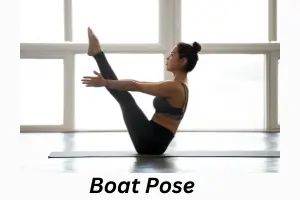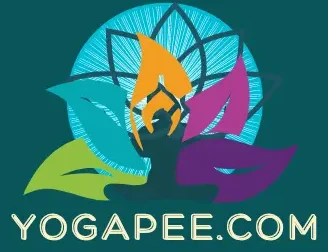Introduction
Boat Pose, known as Navasana in Sanskrit, is a core-strengthening yoga posture that derives its name from the shape of a boat.
This pose effectively engages the abdominal muscles, strengthens the hip flexors, and improves overall balance and focus.
Practicing Navasana regularly helps improve posture, core stability, and endurance, making it a popular pose in many yoga sequences.

This challenging yet rewarding posture not only enhances physical strength but also cultivates mental resilience by requiring sustained concentration and balance.
Additionally, Boat Pose encourages a sense of confidence and inner strength, both physically and mentally.
Steps to Perform Boat Pose (Navasana)
- Start in a Seated Position: Begin by sitting on your yoga mat with your legs extended in front of you and your back straight. Place your hands on the mat next to your hips to help lengthen your spine and engage your core.
- Bend Your Knees: Bend your knees, keeping your feet flat on the floor. As you inhale, gently lean back slightly while keeping your spine long and your chest lifted.
- Lift Your Feet Off the Floor: Slowly lift your feet off the mat while maintaining a balanced position on your sitting bones. Keep your knees bent initially to find your balance, and engage your core to support your spine.
- Straighten Your Legs (Optional): If you’re comfortable, gradually straighten your legs to form a V-shape with your body. Your toes should be at eye level or higher, and your arms should reach forward, parallel to the floor, with palms facing each other.
- Engage Your Core: Keep your abdominal muscles actively engaged to maintain the pose. Avoid rounding your back or collapsing your chest—keep your torso lifted and your spine long.
- Hold the Pose: Stay in Boat Pose for 5-10 deep breaths, focusing on steady inhalations and exhalations. Maintain a steady gaze, either at your toes or slightly upward to help with balance and focus.
- Exit the Pose Mindfully: To release the pose, bend your knees, gently lower your feet back to the mat, and return to a seated position. You can repeat the pose a few times or move into a forward bend to stretch out your back and hamstrings.
Benefits of Boat Pose (Navasana)
- Strengthens the Core Muscles: This is one of the most effective yoga poses for building core strength. It engages the entire abdominal region, including the obliques and lower back muscles, helping improve posture and stability.
- Improves Balance and Stability: Navasana challenges your balance as it requires you to remain steady while engaging your core and hip flexors. Over time, this improves overall body stability and enhances coordination.
- Tones the Abdomen and Hips: By actively working the abdominal muscles and hip flexors, Boat Pose helps tone and sculpt the abdominal region and strengthens the hip flexors, promoting better alignment and flexibility.
- Enhances Focus and Concentration: Holding Navasana Pose requires sustained mental focus to maintain balance and alignment. Practicing Navasana improves concentration, focus, and mental clarity, which can carry over into daily life.
- Supports Digestion: The compression of the abdominal area in Navasana stimulates the digestive organs, which can help improve digestion and alleviate bloating or constipation.
- Strengthens the Spine: This pose engages the muscles that support the spine, helping to strengthen the lower and middle back. This makes it beneficial for improving posture and relieving tension in the back muscles.
- Promotes Emotional Balance: Navasana encourages a sense of confidence, inner strength, and emotional balance. It requires focus and determination, which helps cultivate mental resilience and reduces feelings of stress or anxiety.
- Improves Endurance: Holding Boat Pose for extended periods helps improve muscular endurance, particularly in the core and hip flexors. This can translate into better overall stamina in both yoga practice and other physical activities.
Precautions and Contraindications of Boat Pose (Navasana)
- Lower Back Issues: People with existing lower back problems, such as herniated discs or chronic lower back pain, should avoid or modify This Pose. It’s essential to practice this pose with a neutral spine to prevent straining the lower back.
- Neck Injuries: Individuals with neck injuries or stiffness should avoid straining the neck in Boat Pose. Instead, they should focus on keeping the neck in a neutral position and avoid lifting the head too far forward.
- Pregnancy: Pregnant women, especially in the later stages of pregnancy, should avoid Boat Pose, as it puts pressure on the abdominal area and can strain the lower back. Gentle modifications with support are preferable.
- Hernias: If you have a hernia, avoid Boat Pose as it creates intra-abdominal pressure, which may worsen the condition. It’s essential to consult a healthcare professional before practicing poses that engage the core deeply.
- Hip or Groin Injuries: Individuals with hip or groin injuries should approach Navasana cautiously, as the pose engages the hip flexors and can aggravate certain injuries. Modify the pose by keeping the knees bent if needed.
- Difficulty Maintaining Balance: Beginners or those with balance issues may find it challenging to hold Boat Pose. It’s advisable to start with a supported variation, such as keeping the hands on the floor or using a strap behind the thighs for support.
- Avoid Overarching the Back: To protect the spine, avoid collapsing the chest or rounding the back in this pose. Engage the core muscles and keep the spine long to prevent unnecessary strain on the lower back.
- Use Props if Necessary: For beginners or individuals with limited flexibility, using props such as a folded blanket under the hips or a strap around the feet can provide extra support and help maintain balance in the pose.
Conclusion
- This Pose is a powerful and transformative yoga posture that builds core strength, improves balance, and enhances overall stability.
- Its ability to engage the abdominal muscles while simultaneously strengthening the spine and hip flexors makes it an essential pose in any yoga practice.
- This Pose also promotes mental focus and emotional resilience, as it requires concentration and perseverance to hold the pose.
- However, it’s important to approach this pose mindfully, especially for individuals with lower back or hip issues, by modifying the pose as needed or using props for support.
- When practiced regularly and with proper alignment, This Pose offers a multitude of physical, mental, and emotional benefits.
- Whether you are looking to strengthen your core, improve your balance, or build mental focus, Navasana is a rewarding pose that encourages growth and inner strength.
